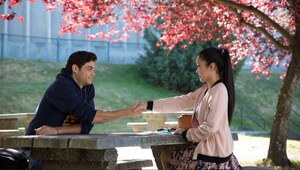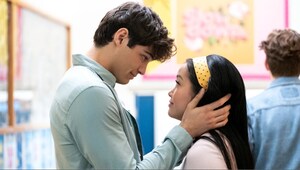18 Scary Books That Are Totally Worth the Nightmares They'll Give You
Find a crowded, well-lit space, and enjoy!

1. Silver: My Own Tale as Written by Me With a Goodly Amount of Murder, by Edward Chupack (2008)

Edward Chupack started with Long John Silver, the dastardly pirate of Robert Louis Stevenson's Treasure Island, and spun this rollicking story of terror on the high seas. Silver is deliciously creepy, full of adventure, loads of murder, and an elaborate, well-crafted mystery. Silver the pirate makes no apologies for the lives he ruins on his quest for treasure, and by the end, you'll fear and respect him as much as his crew does. Well, some of his crew. Remember, you can't ever trust a cutthroat.
2. Rebecca, by Daphne du Maurier (1938)

Daphne du Maurier's ghost-less ghost story about a haunted marriage is on everyone's best scary books list for a reason: Rebecca is utterly chilling. In every scene the unnamed narrator is in the dark, surrounded by fog, or being startled by someone sneaking up on her (in the foggy dark). The literal and psychological miasma grows thicker and thicker as the second Mrs. de Winter explains how she was nearly driven insane at Manderley, her husband's estate where his first wife died under mysterious circumstances.
3. The Secret Place, by Tana French (2014)

The fifth and most recent installment of Tana French's Dublin Murder Squad books, a series of loosely connected crime novels, sees an ambitious young detective investigating a long-ago murder at a private girls' school outside Dublin, Ireland. It hews pretty closely to its genre's traditions, where the police are as troubled as the perps, but French pushes it to weird limits, introducing elements of magical realism (emotionally volatile telekinetic teens) into a narrative about competitive secret-keeping, psychological violence, and desperation. Don't worry, you can breathe again once it's over.
4. Come Closer, by Sara Gran (2003)

This slim volume concerns Amanda, a woman whose perfectly normal life spins out of control as she is possessed by a demon. Which couldn't possibly be mental illness, could it? She wouldn't hear such things, she wouldn't do such things if she were in her own right mind, would she? Of course, with Amanda herself narrating Come Closer, the question of why these things are happening is less important than how she can escape them. Sara Gran packs a lot of terror into not even 200 pages; once you've read them, you may never want to again. Or sleep alone. Or even keep the book in the house.
5. The Haunting of Hill House, by Shirley Jackson (1959)

Shirley Jackson didn't invent the haunted house genre, but she may have perfected it in The Haunting of Hill House. Such stories rely on brave people going into the houses despite all warnings to stay the hell out and maybe set fire to the house and watch it burn down, then salt the earth so nothing can ever return. Jackson's intrepid explorers do no such thing, of course, allowing us the pleasure of being scared to death with them. Like all of Jackson's works, it's as funny as it is terrifying, but don't let the humor lull you into thinking you won't ever want to leave the safety of under the covers.
6. The Turn of the Screw, by Henry James (1898)

What's scarier: actual ghosts, or the idea that you're imagining them? Henry James, America's foremost snob, hated the common ghost story, all screaming and slashing; instead, he gives us a naïve young woman isolated in a house with two children who are acting more and more peculiar, while their wealthy, absent uncle refuses to be bothered by trivialities like whether anyone's life is being threatened by a pair of sinister ghosts or his relations' caretaker is losing her mind. The Turn of the Screw is very short and very scary, and you'll have to read carefully for nuance. But this novella contains multitudes of very real horror.
7. Grotesque, by Natsuo Kirino, translated by Rebecca Copeland (2007)

Sometimes the worst part of a story isn't its graphic violence but its characters' reactions to it. In Grotesque, prolific Japanese crime writer Natsuo Kirino gets the murders and the mystery out of the way, instead ceding the story to the unnamed female narrator who has connections to the two sex worker victims. The narrator talks about the two dead women from her own, twisted perspective — she hated them; she hated all their classmates at their elite private school; she hated her parents. The power of the narrator's spite, her utter disdain for everyone and everything, is so compelling you might find yourself agreeing with her, and then immediately recoiling in horror at how seductive hatred can be.
8. Let the Right One In, by John Ajvide Lindqvist, translated by Ebba Segerberg (2008)

Some vampire stories are all sexy creepiness (or sparkly skin), and some are hardcore blood and violence. John Ajvide Lindqvist's Let the Right One In is definitely in the latter category, one of the most viscerally disturbing entries in the body horror genre. It's not just brutal tortures of the flesh though; through preteen Oskar and his vampiric neighbor, Eli, Lindqvist explores all the gross, sad, disgusting humiliations visited upon the body and the soul. It's as dark as its Swedish setting, where the sunlight is too weak to cleanse the characters of their sordid, pathetic sins.
9. It, by Stephen King (1986, Viking)

Nothing is as terrifying as it is in childhood, when imagination is at its most powerful and monsters can lurk in every shadow. In horror master Stephen King's It, a monster really is lurking in every shadow, taking the form of what most scares each child in the little town of Derry, Maine. (Often a clown, because clowns are inherently terrifying.) A group of friends who call themselves the Losers Club repels the monster — but not for good, of course, because what's the most frightening book about childhood terrors and small-town prejudice without an (almost) unkillable monster? The majority of King's oeuvre qualifies as "pants-wettingly scary," but It, with its young victims and horrible, horrible clown, may be the scariest.
10. The Dinner, by Herman Koch, translated by Sam Garrett (2013)

The farther a story is set from an urban center, the grosser, creepier, and genuinely worse its secrets become. Similarly, (fictional) wealthy people's secrets are worse than their middle-class counterparts'. Herman Koch knows this, which is why the secrets buried at the heart of The Dinner will make you feel sicker and sicker the closer you get to uncovering them. Solving the mysteries before the unreliable and increasingly unhinged narrator — one of the fathers of two boys who have run into some trouble, necessitating their parents have dinner to work things out — reveals them won't make you feel any better either; there's plenty of terror in anticipation.
11. Entering Hades: The Double Life of a Serial Killer, by John Leake (2008)

The psychopath is modern society's favorite villain, and for good reason: They live among us, they look just like us, and they see us as prey. John Leake writes about a particularly terrifying psychopath in Entering Hades, the true story of Jack Unterweger, a man who was convicted of serial murders, briefly imprisoned, freed, began killing again, and then became the foremost expert on the murders he was secretly committing. Unterweger so charmed everyone — the intellectuals who agitated for his release, the 23 women he murdered, even his victims' families — that he almost got away with it. Real life is always scarier than fiction.
12. A Good Man Is Hard to Find and Other Stories, by Flannery O'Connor (1955)

As far as nauseating horror tropes go, the malevolent stranger is a pretty effective one, and Flannery O'Connor thoroughly exploited it in A Good Man Is Hard to Find and Other Stories. From the story that lends the book its title, in which a warning of a killer on the loose goes unheeded by a family, to the awful murder in the final tale, O'Connor captures the everyday grotesque, with small people living squalid lives, the tedium only interrupted by bursts of horrible violence.
13. Shadowshaper, by Daniel José Older (2015)

How about a young adult novel set in Brooklyn, featuring zombies, ghosts, family magic, dangerous mysteries, and super best friends? Daniel José Older's Shadowshaper tells the story of Sierra Santiago, a teenager who is ready to spend the summer painting murals and going dancing with her friends — until the figures in her murals start weeping, she's attacked by a malevolent spirit on a dark street, and her once-familiar neighborhood has transformed into a danger zone, with evil lurking around every corner. Older's fantasy makes the ordinary extraordinary, touching on social issues while managing to be genuinely suspenseful.
14. People Who Eat Darkness: The True Story of a Young Woman Who Vanished From the Streets of Tokyo — and the Evil That Swallowed Her Up, by Richard Lloyd Parry (2012)

True crime has a well-earned reputation for seediness, the literary version of gawking at an accident. Though his subject is the gruesome murder of a 21-year-old Englishwoman in Japan — a case that was outrageously sensationalized by the British press when Lucie Blackman's dismembered body was discovered buried in a cave — Parry does not sensationalize People Who Eat Darkness. Instead, he uses careful investigation and great interviews to explain the facts of the case; Lucie's "meaningless, brutal, premature death" is made all the more frightening by how easily it could have happened to any of her peers. There is a horrible darkness in the story of Lucie Blackman, and Parry's recounting of it is chilling.
15. The Monster of Florence, by Douglas Preston and Mario Spezi (2008)

Of course we are fascinated by serial killers. The repetition of the crimes, the elaborate tableaux, the police always a step behind the murderer — they are deeply disturbed and totally absorbing. When crime writer Douglas Preston moved with his family to Florence, he stumbled into a decades-long investigation into the most prolific serial killer in Italy, the so-called Monster of Florence. The resulting book, co-written by Italian journalist Mario Spezi, details not only the gory details of the crimes but the aggressively terrible job by law enforcement, whose every stupid move made it easier for the monster to rack up his victims. While the murders themselves are awful, the scariest part of The Monster of Florence is how incompetent policing and prosecuting can be just as dangerous as a violent murderer.
16. Spook: Science Tackles the Afterlife, by Mary Roach (2005)

Is there something beyond death? Is there any way to find out? Expert explainer Mary Roach wants to know what happens after we die, or rather, she wants to know what other people have discovered about it. In Spook, she visits mediums, ghost hunters, and scientists; she researches the spiritualism and ectoplasm that captivated scary storywriter Sir Arthur Conan Doyle; she watches an experiment in near-death. Throughout, she keeps a skeptic's eye on the (often ridiculous) goings-on, but, as she puts it, "I believe that not everything we humans encounter in our lives can be neatly and convincingly tucked away inside the orderly cabinetry of science." The science may not be there, but death can't possibly be all there is.
17. Annihilation, by Jeff VanderMeer (2014)

Something horrible has happened in Area X, something that humanity feels compelled to explore, even though 11 previous expeditions have failed, horribly. What waits for the four women of the 12th expedition in Annihilation, the first is weirder and more awful than anything they could have imagined — unless they're imagining the entire thing. Jeff VanderMeer's descriptions are so vividly disgusting, and the uncanny world he creates is so disorienting, you'll rip through Annihilation and need to put your head between your knees to keep from passing out. Consider the one-two-three punch of the entire Southern Reach Trilogy a challenge only for the strongest of constitutions.
18. Zone One, by Colson Whitehead (2011)

With the many iterations of The Walking Dead, Zombieland, Resident Evil, Shawn of the Dead, Pride and Prejudice and Zombies — what more is there to say about humanity's apparently imminent self-destruction? In Colson Whitehead's skilled hands, however, the end of the world is just the beginning. Zone One is as scary and horrible and creepy as you'd expect from a story about a man calling himself Mark Spitz who's just trying to stay alive. It's also quite moving. Whitehead is particularly good at world-building; here, people cling to their last shreds of humanity as they try to reestablish civilization among the ruins of New York City.
Follow Meave on Instagram.
more from Life

Just calculated Taylor Swift’s net worth and now I’m crying

8 vanilla-infused beauty products for summer

#AllEyesOnB: Beauty launches on our radar this April

Your most pressing questions about Bipolar 1 Disorder, answered by people who know

What the first trip with your partner says about your relationship

Signs that you’re a bad packer on your holidays and how to avoid them

Lessons that my string of unhealthy relationships taught me

Everything you need to know about the "Who is Your Chicago?" trend

Masoom Minawala pens down a quintessential guide for every woman who wants to prove the world wrong

#AskTheTherapist: ‘Should I break ties with my toxic sister?’
